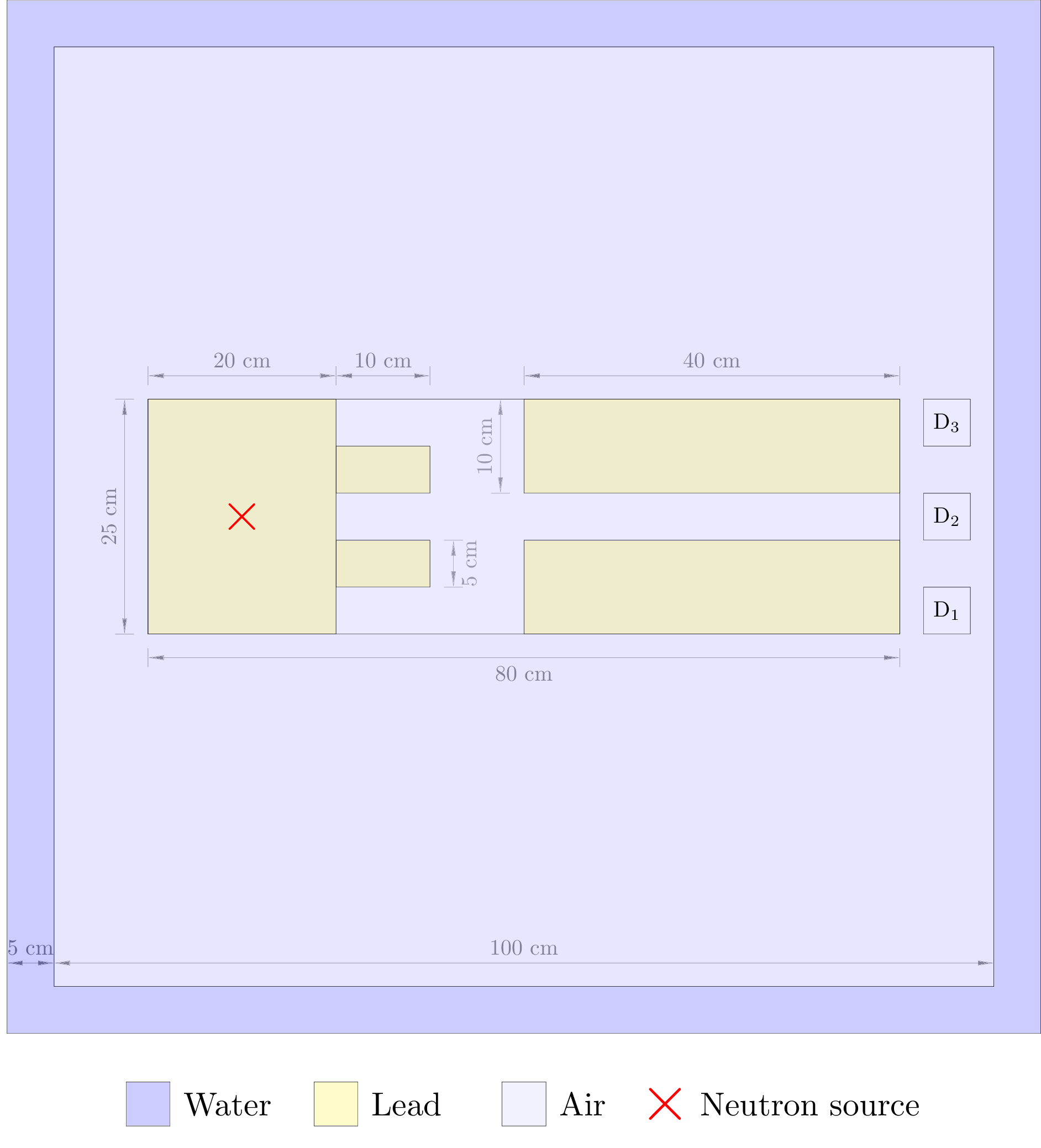1
2
3
4
5
6
7
8
9
10
11
12
13
14
15
16
17
18
19
20
21
22
23
24
25
26
27
28
29
30
31
32
33
34
35
36
37
38
39
40
41
42
43
44
45
46
47
48
49
50
51
52
53
54
55
56
57
58
59
60
61
62
63
64
65
66
67
68
69
70
71
72
73
74
75
76
77
78
79
80
81
82
83
| import numpy as np
import openmc
import openmc.capi
from openmc.stats import Point
model = openmc.model.Model()
model.settings.batches = 5
model.settings.inactive = 0
model.settings.particles = 100
model.settings.run_mode = 'fixed source'
model.settings.output = {'tallies':True, 'summary':True}
source = openmc.Source()
source.space = Point(xyz=(-30.0, 0.0, 0.0))
source.energy = openmc.stats.Discrete([14.0*1e6], [1.0])
model.settings.source = source
model.settings.dagmc = True
model.settings.export_to_xml(path='settings.xml')
tally = openmc.Tally()
tally.scores = ['flux']
energy_bins = np.array([0.0,
1.00001E-007, 4.13994E-007, 5.31579E-007, 6.82560E-007, 8.76425E-007,
1.12535E-006, 1.44498E-006, 1.85539E-006, 2.38237E-006, 3.05902E-006,
3.92786E-006, 5.04348E-006, 6.47595E-006, 8.31529E-006, 1.06770E-005,
1.37096E-005, 1.76035E-005, 2.26033E-005, 2.90232E-005, 3.72665E-005,
4.78512E-005, 6.14421E-005, 7.88932E-005, 1.01301E-004, 1.30073E-004,
1.67017E-004, 2.14454E-004, 2.75364E-004, 3.53575E-004, 4.53999E-004,
5.82947E-004, 7.48518E-004, 9.61117E-004, 1.23410E-003, 1.58461E-003,
2.03468E-003, 2.24867E-003, 2.48517E-003, 2.61259E-003, 2.74654E-003,
3.03539E-003, 3.35463E-003, 3.70744E-003, 4.30742E-003, 5.53084E-003,
7.10174E-003, 9.11882E-003, 1.05946E-002, 1.17088E-002, 1.50344E-002,
1.93045E-002, 2.18749E-002, 2.35786E-002, 2.41755E-002, 2.47875E-002,
2.60584E-002, 2.70001E-002, 2.85011E-002, 3.18278E-002, 3.43067E-002,
4.08677E-002, 4.63092E-002, 5.24752E-002, 5.65622E-002, 6.73795E-002,
7.20245E-002, 7.94987E-002, 8.25034E-002, 8.65170E-002, 9.80365E-002,
1.11090E-001, 1.16786E-001, 1.22773E-001, 1.29068E-001, 1.35686E-001,
1.42642E-001, 1.49956E-001, 1.57644E-001, 1.65727E-001, 1.74224E-001,
1.83156E-001, 1.92547E-001, 2.02419E-001, 2.12797E-001, 2.23708E-001,
2.35177E-001, 2.47235E-001, 2.73237E-001, 2.87246E-001, 2.94518E-001,
2.97211E-001, 2.98491E-001, 3.01974E-001, 3.33733E-001, 3.68832E-001,
3.87742E-001, 4.07622E-001, 4.50492E-001, 4.97871E-001, 5.23397E-001,
5.50232E-001, 5.78443E-001, 6.08101E-001, 6.39279E-001, 6.72055E-001,
7.06512E-001, 7.42736E-001, 7.80817E-001, 8.20850E-001, 8.62936E-001,
9.07180E-001, 9.61672E-001, 1.00259E+000, 1.10803E+000, 1.16484E+000,
1.22456E+000, 1.28735E+000, 1.35335E+000, 1.42274E+000, 1.49569E+000,
1.57237E+000, 1.65299E+000, 1.73774E+000, 1.82684E+000, 1.92050E+000,
2.01897E+000, 2.12248E+000, 2.23130E+000, 2.30693E+000, 2.34570E+000,
2.36533E+000, 2.38513E+000, 2.46597E+000, 2.59240E+000, 2.72532E+000,
2.86505E+000, 3.01194E+000, 3.16637E+000, 3.32871E+000, 3.67879E+000,
4.06570E+000, 4.49329E+000, 4.72367E+000, 4.96585E+000, 5.22046E+000,
5.48812E+000, 5.76950E+000, 6.06531E+000, 6.37628E+000, 6.59241E+000,
6.70320E+000, 7.04688E+000, 7.40818E+000, 7.78801E+000, 8.18731E+000,
8.60708E+000, 9.04837E+000, 9.51229E+000, 1.00000E+001, 1.05127E+001,
1.10517E+001, 1.16183E+001, 1.22140E+001, 1.25232E+001, 1.28403E+001,
1.34986E+001, 1.38403E+001, 1.41907E+001, 1.45499E+001, 1.49182E+001,
1.56831E+001, 1.64872E+001, 1.69046E+001, 1.73325E+001, 1.96403E+001])
energy_filter = openmc.EnergyFilter(energy_bins*1e6)
tally.filters.append(energy_filter)
mesh = openmc.Mesh(mesh_id=14, name="n_flux")
mesh.dimension= [16, 5, 1]
mesh.lower_left = (-40.0, -12.5, -2.5)
mesh.upper_right = (40.0, 12.5, 2.5)
mesh_filter = openmc.MeshFilter(mesh)
tally.filters.append(mesh_filter)
tallies = openmc.Tallies()
tallies.append(tally)
tallies.export_to_xml()
openmc.run()
|
